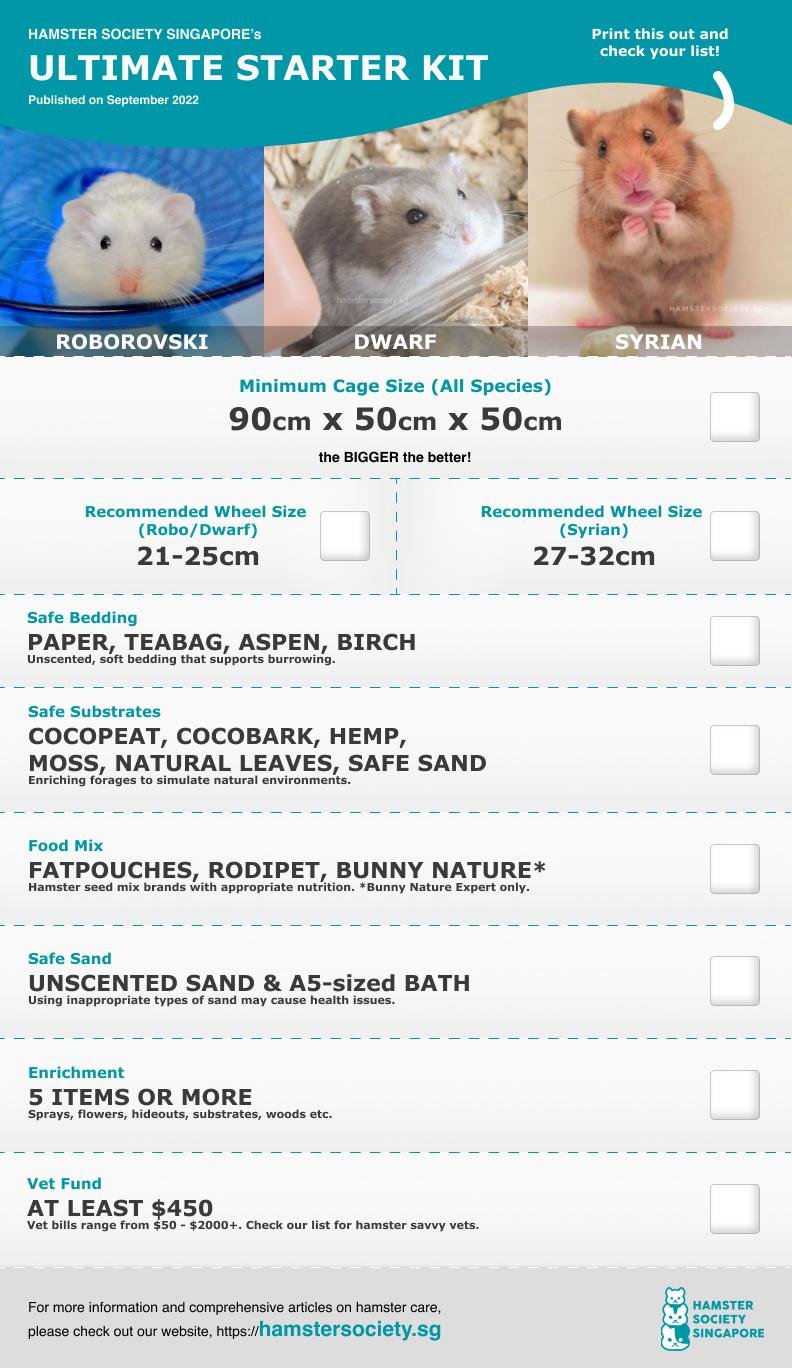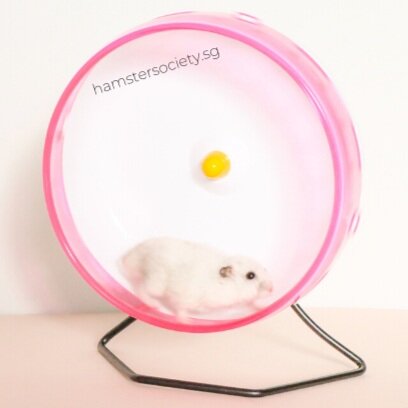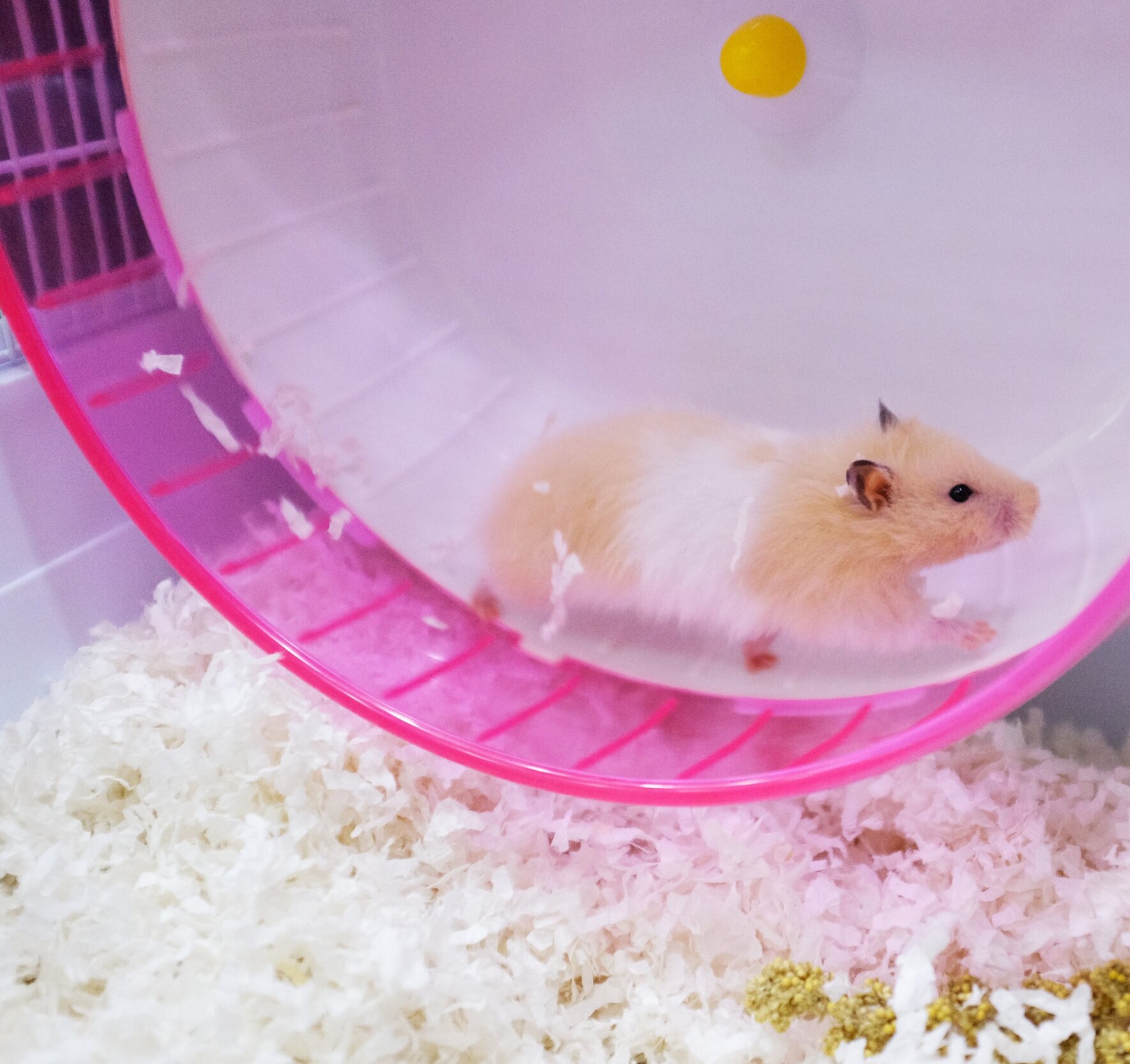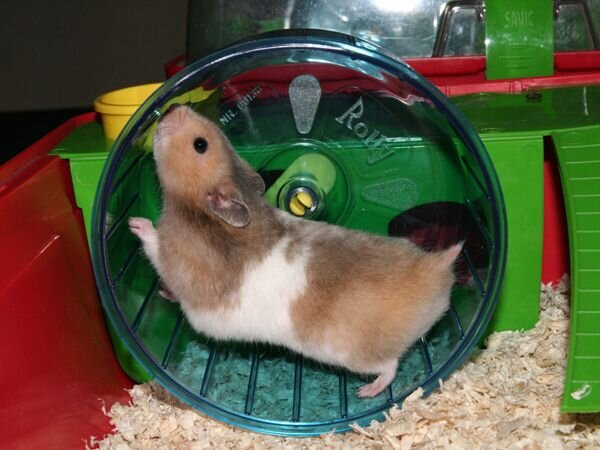If you’re going to be a first-time pawrent of a hamster, you must be wondering about all the necessities you’re going to need. Let’s help you get sorted with all the right basics! We encourage that you also do more research on your own, beyond this basic Starter Kit.
Getting a hamster:
When you adopt a hamster from a shelter, you’re giving it a new lease of life in a forever home and freeing up a spot for another hamster to be rescued into our caring foster homes!
Now let’s explore if a hamster the right pet for you:
☐ Do you have the space for a proper hamster cage?
HSS has set the minimum requirements for ALL adoptions to 90x50x50cm as research has shown that hamsters thrive in larger spaces, so bigger is always better!
☐ Would you keep your hamster by itself?
☐ Are you willing to take your hamster to the vet should it require medical treatment?
☐ Would you strive to provide the best possible life for your hamster?
If you answered YES to the questions above, you’re on the right track to being an awesome pawrent!
⚠️Please reconsider owning a hamster if you want to breed your hamster (please don’t!) or get one as a gift to your kids or friend. ⚠️
What cage TO get?
HSS recommends a cage that is 90x50x50cm or larger for any hamster.
One hamster per cage, always! Hamsters are solo pets.
Suitable cages in Singapore:
But, pet shops sell them! Can I not just connect them together??
1. The size of those cages are still way too small for any hamster and still can’t fit the right wheel.
2. Small enclosures has been scientifically found to increase stress and contribute to cage aggression i.e: biting. (reference 1) (reference 2)
3. Connecting one small cage to another small cage cannot provide the same enrichment as proper unbroken floor space can.
WHAT IS A SPECIES APPROPRIATE WHEEL?
Wheel has to be big enough for hamster to run with a straight back
Dwarves (including Robos): 21cm-30*cm
Suitable wheels for Dwarves (including Robos) in Singapore:
Acrylic Wheels, Niteangel
*Dwarf hamsters are also able to run in 30cm wheels, if the wheels are made of lightweight plastic and easy to turn, i.e. Trixie wheels. 30cm Acrylic wheels (ie Wild Sanko) are too heavy for a dwarf hamster to turn.Syrians: 27cm or larger
Suitable wheels for Syrians in Singapore:
Acrylic Wheels, Niteangel, Kaytee, Carno
A dwarf hamster running on a 21cm wheel. Before, he was a rescue living a small cage with a tiny wheel.
A young syrian hamster on a 30cm wheel. Syrians do grow longer, note her straight back!
A hamster in the wild can run 9-21km (5-13 miles) as they search and forage for food. It is very important to provide a suitable sized wheel for your hamster to run on to work off their energy.
WHY IS THIS REQUIRED?
We have noted from our rescues that hamsters running in small wheels often have lasting spinal damage or muscular atrophy from frequently curving their spines unnaturally, similar to hunchbacks in humans!
Signs that your wheel is too small:
1. Your hamster is hunched when running.
2. Your hamster is running the wheel from the outside (i.e. pawing at the exterior of the wheel)
3. Your hamster is showing signs of cage aggression (i.e. biting of the cage)
Suitable wheels in Singapore:
SAFE BEDDING AND SUBSTRATES
[Click here to read more about bedding]
What hamsters need:
Hamsters love to burrow in DEEP bedding. Burrowing is one of their natural instincts.
We recommend AT LEAST 10cm of bedding in depth, compressed (pressed down instead of fluffed up) to allow for better burrowing. Scientific research shows that deep bedding enhanced welfare in hamsters by providing an outlet for their natural instinct. This amount of bedding actually helps with odour control as the liquid is wicked up quickly by the amount of dry bedding.
UNSAFE bedding:
x Scented bedding
x Only pellets (E.g. back2nature, breeder select…)
x Cotton
x Pine or Cedar substrates
SAFE bedding in Singapore:
Aspen (shredded, flakes - shredded produces more dust, do note for sensitive owners)
Birch bedding
Soft paper bedding
Teabag bedding
Tissue paper strips
SUBSTRATES
What are substrates?
Substrates allow your hamsters to explore different textures under their paws, and provide a form of enrichment for them by simulating natural environments.
Safe substrates include:
Cocopeat
Cocobark
Hemp bedding
Meadow hay
Mountain grass
Natural leaves
Sand
Moss
Are “bedding” and “substrates” the same thing?
The simple answer is NO!
Hamsters have poor eyesight and rely heavily on their sensory experience to explore their surroundings. While they will enjoy digging different substrates, many substrates are simply not ideal for burrowing and nesting. This is why we recommend having a main area of bedding for burrowing, and several contained areas of substrates for enrichment.
Natural materials such as cocopeat, cocobark and other soil based mediums (insert picture) dry out very quickly, and needs to be kept damp to ensure it does not get too dusty. As this substrate requires regular watering to ensure it is safe for use, it should only be used in a well ventilated area to prevent mould from growing! Constant turnover of the soil via digging and kicking along with good air flow will prevent mould from growing. Remember to keep it damp, but not soaking wet.
Hemp bedding is fun to dig, but does not hold burrows.
Meadow hay, mountain grass, hay and leaf based alternatives can be added or layered in between bedding for your hamsters to create stronger burrows (We do not recommend timothy hay, as they are very hard and like twigs).
Sand is not only a good digging medium, but it allows them to keep themselves clean as hamsters do not bathe in water. We recommend A5 sized sand pits or bigger, to allow them enough digging space and to prevent your hamsters from rolling into their own pee spots. This also allows you to be able to scoop up soiled areas easily, and ammonia does not build up as quickly in small “hamster toilets”.
We recommend having these areas in it’s separate containers (ie digging pits) to keep the substrate contained (hamsters are strong kickers!) and for easy cleanup as well.
Food and the right nutrition
Hamsters are granivores! They love their vegetables, fruits, seeds and bugs (or meat). Hamsters are foragers by nature, so seed mixes and staple food with a good variety of ingredients are great for them.
You may think that certain commercial seed mixes at pet shops are sufficient, but do take a closer look at the packaging! Many are lacking in much of the nutrition that hamsters need, or have too many pellets.
Required Nutrition:
PROTEIN . FAT . FIBRE
0-6 months
Protein: 19-20%, fat: 7-8%, fiber: 8-10%
6-18 months
Protein: 17-18%, fat: 6-7%, fiber: 10-12%
>18 months
Protein: 15%, fat: 6-7%, fiber: 12-15%
(No longer recommend lab blocks as a requirement for staple feed, As long as they are fed a varied and diversified diet, there is no need to add on lab blocks.)
So, which brands in Singapore have better nutrition?
SAND
Hamsters often groom themselves to keep clean. Unlike humans and dogs, they do not need water and soap to maintain clean and healthy fur. Instead, sand baths help to remove grease and dirt from your hamster’s fur. Your hamster may use the sand bath as a litter tray, which is perfectly fine - and all you need to do is sift out the soiled bits so you can re-use the sand several times over.
Unsafe with risks of respiratory illnesses:
x Scented sand - Hamsters are sensitive to these fragrance added sands and can cause irritation in their respiratory tract
x Chinchilla dust - Dust baths are made from extremely fine particles which are not suitable for a hamster’s lungs
x Baby powder - Talc is a soft clay mineral, extremely fine when powdered and not suitable for a hamsters lungs, nor does it help in “brushing off” dirt and excess oils the same way that grittier sand particles would
Safe sand in Singapore:
Hideouts/ enrichment
Hamsters are prey animals and possess the instinct to hide and find safe places. In the wild, they burrow underground and even make their own chambers! Hamsters shouldn't simply be treated as exhibits in your home; allow your hamster's home to be its haven!
Natural cage setups are hugely popular in the hamster community. Safe enrichment items include wood pieces.
Bamboo roots - Climb on, support burrows
Grapevines - Climb on, hang treats, support burrows
Coffewood - Climb on, hang treats, support burrows
Cork - Climb on, support burrows
Different substrates - (Scroll up for explanation on substrates)
Leaves, flowers, herbs - Add a variety of colors to your enrichment, and provide a safe way for your hamster to explore and nibble
Sprays - No, this is not what you are thinking. Sprays are the generic term for grains and seeds in it’s natural harvested form, before the grains are separated from the pods and stalks. This not only serves as decor in your enclosure, but allows your hamster to forage and nibble around.
Stones/pebbles/marble - Can be little stepping stones, or a cool surface for your hamster to rest on
Hideouts - We are spoilt for choice with the availability of hideouts in Singapore, ranging from wooden houses, to acrylic multi-chambers. Go for ceramic or acrylic items for easy cleanup, or wood based hideouts for a natural look.
TEMPERATURE
Here is a quick but highly important note on temperature!
The ideal temperature for hamsters is 25 degrees with 40% humidity. Your hamsters may not burrow if the temperature is too warm. We do not advise keeping your hamsters on the balcony, even when it is shaded as it can still be warm in tropical Singapore.
Do keep your hamster indoors, in the coolest part of your house with good airflow and ventilation if you do not have air conditioning.
A Vet Fund
Last but most certainly not least. In fact, this could be the #1 consideration before starting to shop for anything else!
Yes, hamsters actually do need to go to the vet if they fall ill! Not all vets see hamsters, though. Keep this map below handy just in case.
A trip to the vet can cost anywhere from under $100, $100-$300 and up, or even in the four-digit range depending on the treatment. We advise setting aside some money for it or however you prefer to manage this Fund.
As with all pets, hamsters are susceptible to falling ill. Hamsters also have an array common illnesses which you can learn more about here.
Don’t forget to continue doing your own research! :)
”But, I trust the expertise pet shops are supposed to have!”
““For decades, pet shops have falsely marketed hamsters as “cheap and easy pocket pets” in order to boost their sales of the animal and their corresponding care supplies. Many pet shop employees also blindly trust that the products they are encouraging customers to buy are perfectly suitable, and are unintentionally contribute to the neglect of these animals.” ”













